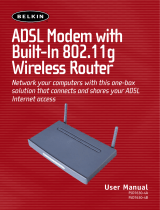
4
(ALG) are supported such as web browser, ICQ, FTP, Telnet, E-mail, News,
Net2phone, Ping, NetMeeting, IP phone and others.
Firewall
Supports simple firewall with NAT technology and provides option for blocking access
from Internet, like Telnet, FTP, TFTP, WEB, SNMP and IGMP.
Domain Name System (DNS) relay
Provides an easy way to map the domain name (a friendly name for users such as
www.yahoo.com) and IP address. When a local machine sets its DNS server with this
router’s IP address, every DNS conversion request packet from the PC to this router
will be forwarded to the real DNS in the outside network.
Dynamic Domain Name System (DDNS)
The Dynamic DNS service allows you to alias a dynamic IP address to a static
hostname. This dynamic IP address is the WAN IP address. For example, to use the
service, you must first apply for an account from a DDNS service like
http://www.dyndns.org/.
PPP over Ethernet (PPPoE): Provides embedded PPPoE client function to establish a
connection. Users can get greater access speed without changing the operation
concept, sharing the same ISP account and paying for one access account. No PPPoE
client software is required for local computer. The Automatic Reconnect and Disconnect
Timeout (Idle Timer) functions are provided, too.
Virtual Server: User can specify some services to be visible from outside users. The
router can detect incoming service request and forward it to the specific local computer
to handle it. For example, user can assign a PC in LAN acting as WEB server inside and
expose it to the outside network. Outside user can browse inside web server directly
while it is protected by NAT. A DMZ host setting is also provided to a local computer
exposed to the outside network, Internet.
Users can specify some services to be visible from outside users. The router can
detect incoming service requests and forward either a single port or a range of ports to
the specific local computer to handle it. For example, a user can assign a PC in the
LAN acting as a WEB server inside and expose it to the outside network. Outside users
can browse inside web servers directly while it is protected by NAT. A DMZ host setting
is also provided to a local computer exposed to the outside network, Internet.
Dynamic Host Configuration Protocol (DHCP) client and server
In the WAN site, the DHCP client can get an IP address from the Internet Service
Provider (ISP) automatically. In the LAN site, the DHCP server can allocate a range of




















